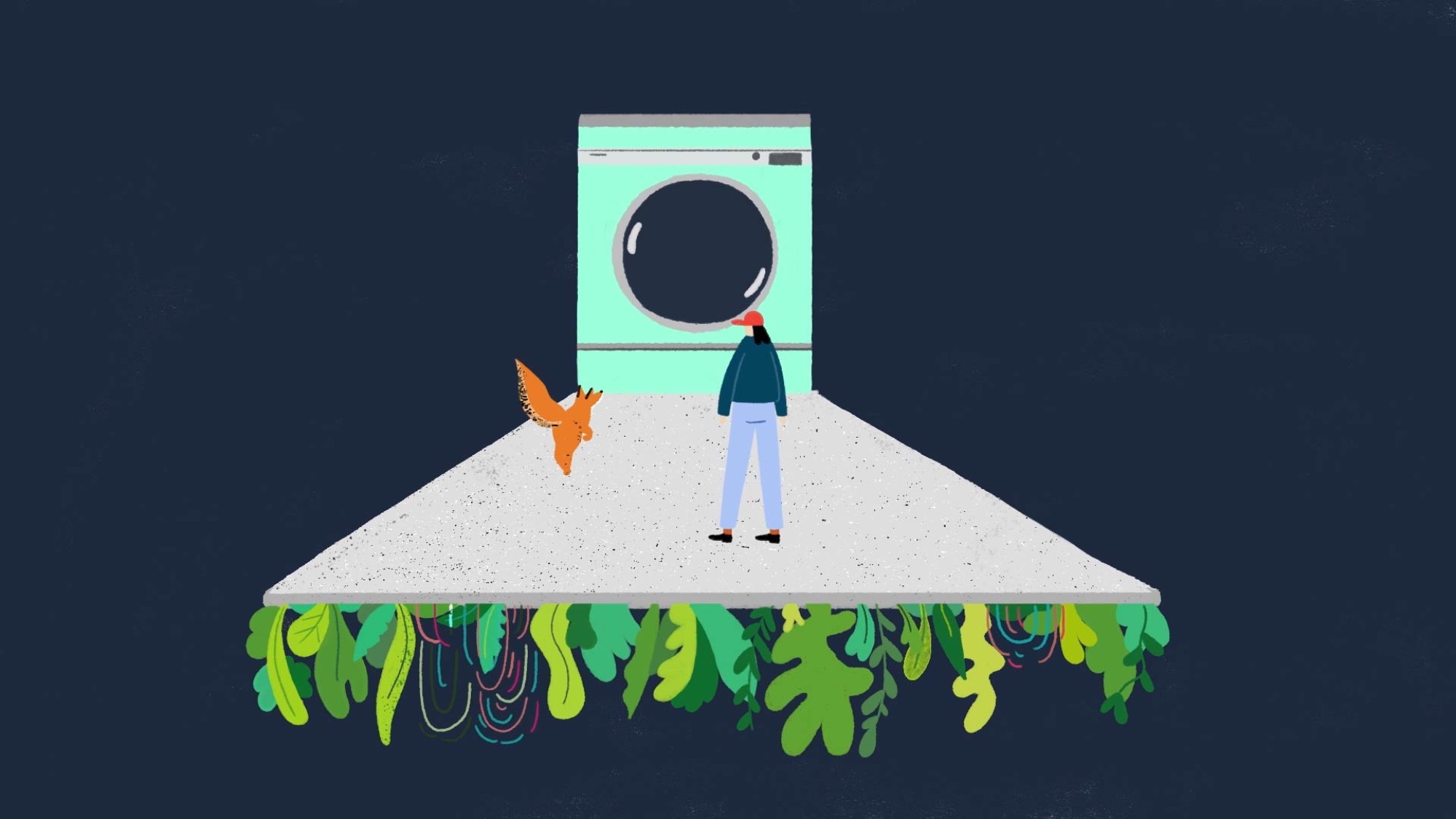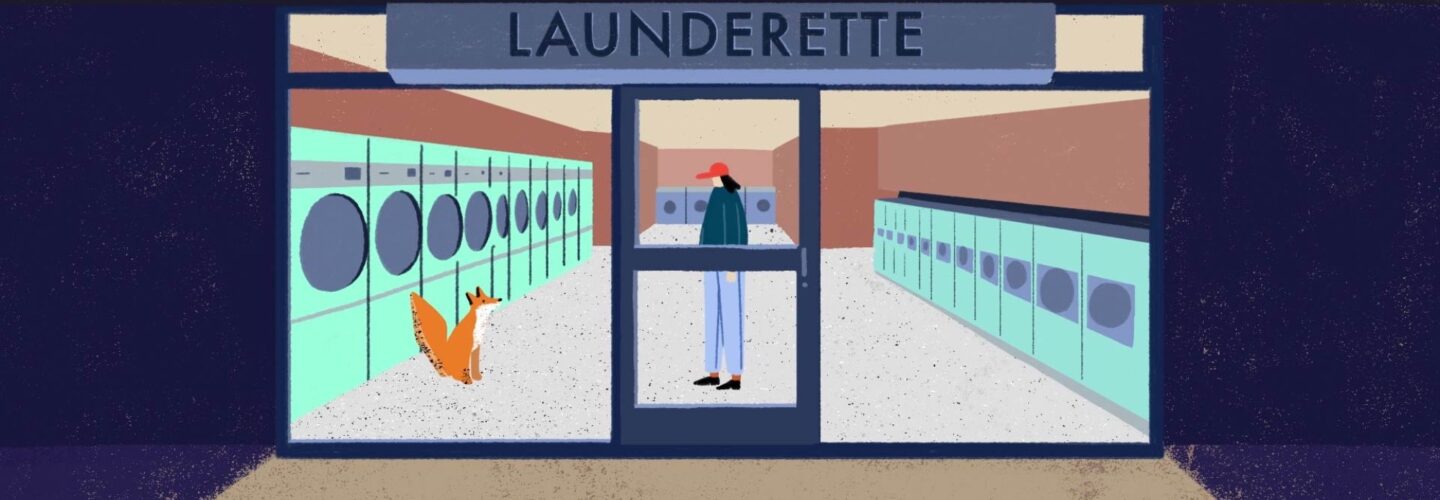
Returning to our pages for her fourth appearance is Director Hannah Jacobs who shares with us her BAFTA nominated animation Your Mountain is Waiting, a short film produced by production company Strange Beast about embracing your instincts and facing the uncertainties of life head on. Jacobs tells her story with a subtle, gorgeous fluidity as her protagonist Martha, who is wrestling with her sense of intuition, smoothly drifts from quiet and introspective moments into vast surreal dreamscapes. Her visual style has a hand-drawn and illustrative sensibility too which gives its cast of characters, which is mostly made up of a wonderful variety of animals, a comforting comic feel. DN spoke with Jacobs, in the run up to the BAFTA awards ceremony, to discuss her journey into animation as a practice, the introspective nature of her narrative, and the importance of colour as tool to establish mood.
What first brought you to animation as an art form?
I think animation has been on my radar from a very young age. I remember going to the library to rent old Asterix and Obelix VHS and would get lost for hours reading comics like Garfield and the Beano, so that passion for visual storytelling has always sparked my interest. I was constantly drawing as a kid and even remember making little flick books, the idea of being able to bring drawings to life in such a simple and quick way really fascinated me.
From there it has slowly evolved over the (many!) years. I studied Illustration at Brighton University but often felt frustrated with not being able to bring my drawings to life. I began experimenting a bit with stop motion, mixing live action and starting to very slowly bring more movement and life into my work. Animation was beginning to crop up much more in popular culture as well, particularly for music videos in the early 2000s. I was massively influenced by directors like Michel Gondry, Spike Jonze and Chris Cunningham.
I later attended the Royal College of Art where I studied an MA in Animation which was wonderful and really shifted how I viewed the medium and how I could approach it from a more creative angle. I wasn’t getting bogged down in the technical aspects of it all, which felt very liberating.
What drew you to tell a story about a person confronting the irrational in order to trust their instincts?
The story really stemmed from a conversation between myself and Harriet Gillian who wrote the film. It was a theme that had certainly cropped up for both of us in our own lives at various points, and particularly at that moment in time felt like quite a poignant topic for us. It feels like it’s often so easy to accidentally lose touch with our intuition and how the journey it can sometimes take to reacquaint yourself with and learn to trust that curious little voice all over again, can at times seem irrational and full of the unexpected.

Harry and I had only met about six months before we started the film but we seemed to have covered all the big topics right out the gate. Part of that was talking about times we’d each lost sense of which way was up and what we’d done about it or what had got us through. So it seemed like a very natural theme for us to then go down the rabbit hole with for our film.
One of the aspects I really enjoyed was the abstract nature of the story, there’s space for contemplation and interpretation in how you chose to tell this narrative. During the writing stage with Harriet, did you ever find yourselves wrestling with this and feeling the need to explain more to the audience?
I think it was actually the opposite for me. My natural way of creating work is to lean into the abstract and ambiguous, leaving space for the audience to make their own interpretation. So for me it was the more literal moments in the film that took a bit of adjusting to, figuring out how to approach them in a way that didn’t feel overly obvious or boring.
It was important to me to create a juxtaposition between the more stoic and still moments in the film, alongside the surreal and dreamlike scenes.
It was a real wrestling match with the part of my brain that found it hard to let a shot be as simple as it needed to be, which I came to realise was actually necessary to let the wilder, more dreamlike scenes work. It was important to give those some context and ground them in a more everyday narrative for the film to make sense.


The animation is gorgeous and fluid but there’s also a slightly almost-nightmarish quality to it, how would you describe the visual tone you set out to create?
I think we wanted the visual tone to reflect the journey of our protagonist. It was important to me to create a juxtaposition between the more stoic and still moments in the film, alongside the surreal and dreamlike scenes. Also to create a visual language that reflected the arc of her story, moving from a space that felt more ominous and heavy to something much lighter and hopeful by the end. This was also reflected in the style of animation and colour palettes that I adopted. Moody tones of blue and purple that eventually made way for much brighter more optimistic colours, greens, oranges, yellows, etc.
How much planning went into achieving that fluidity? There’s so many seamless transitions, were they all laid out during pre-production?
Yes there was a fair bit of planning! We created quite a solid animatic and storyboard in order to get those moments timed out, but it was really down to the incredible skill of the animators that made those shots so special and so beautiful. Harriet, who not only wrote the film but was lead animator, was a really key person in achieving that stunning fluidity. She has an incredible eye for detail and we have a really intuitive understanding of how we envisage a shot working, so she was able to bring those ideas to life in such a magical way.



How long did it take to make Your Mountain is Waiting from idea inception through to the final cut?
In total it took about two years from the initial idea to the final film being completed. The first stage of the project was broken up a bit as we were applying for the BFI Animation Short Film Fund back in October of 2019. As we had some fast approaching, non-moveable deadlines it actually was helpful in us getting going with story, design and some initial animation tests. We were incredibly fortunate to secure the grant and we went into official development in March 2020, just in time for a worldwide pandemic!!
I wanted to create as near to a visceral experience for the viewer as possible.
As Harry and I were both busy working on various animation projects we actually didn’t officially kick off development until the Summer of 2020. We worked closely alongside the BFI who assisted us in developing and fine tuning the script, and then animation began just before Christmas.

The score has a meditative quality to it which feels perfectly in line with the dreamlike narrative, what conversations did you have with Kerry Leatham when developing that portion of production?
I wanted to create as near to a visceral experience for the viewer as possible and knew that the music was going to play a huge role in this, particularly as we weren’t having any dialogue in the film. Kerry and I started having conversations very early into production, sharing drawings and music references back and forth. It was important to me to guide Kerry but let there be enough breathing room for the composition to evolve in a very fluid and organic way, much like the narrative and visuals.
This allowed for some experimentation along the way, working with analogue techniques which brought about some unexpected moments in the score. Playing things in reverse, using tape recordings and creating sequences of chords with old synths allowed for things to not feel overly polished or produced. Kerry has a very intuitive way of working, she really is a master at creating incredibly beautiful and atmospheric compositions, and capturing the tone of a film perfectly.
What’s next for yourself?
I hope to have the opportunity to continue working on more freelance directing jobs and Harriet and I have something up our sleeves to begin work on a longer format project together. Hopefully lots more exciting things in-between too!


